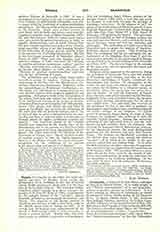

Upsala, UNIVERSITY OF, the oldest and most celebrated university of Sweden. Even today the arrangement of its buildings in the city of Upsala (about 23,000 inhabitants) shows that it is the creation of the Catholic Church. The venerable Gothic cathedral, which contains in a silver reliquary the remains of St. Eric the King (d. 1161), is surrounded by the colleges, houses of the “nations”, clinical hospitals, infirmaries, astronomical observatory, and library. The proposal to call foreign scholars to Upsala to give lectures is said to have been made at the church synod held at Arboga in 1417. It is certain that the bishops were commissioned by the Synod of Sodercoping (1441) to take measures to obtain a studium generate. Shortly after this Denmark sought to establish a university at Copenhagen.
This led Archbishop Jakob Ulfsson, primate of the Swedish Church (1470-1515), a man who did much for Sweden, to seek from the pope the privilege of founding a university. In the summer of 1477 the envoy of the archbishop and the royal council, Canon Ragvald Ingemundi, returned from Rome bringing with him from Pope Sixtus IV a Bull, dated February 27, 1477, granting the charter. The university was to be modeled on that of Bologna, to have the same privileges and liberties, and to include the faculties of theology, canon and civil law, medicine, and philosophy. The Archbishop of Upsala was to be the chancellor and to grant the degrees of bachelor, licentiate, doctor, and master. After receiving the Bull, the archbishop and his six suffragans, the administrator of the kingdom, Sten Sture I, and the twenty-three members of the royal council of Strengnas proceeded to the actual founding of the university on July 2, 1477. The lectures began in the autumn of the same year, and the university developed and flourished greatly.
Religious schism appeared at the university during the rectorship of Laurentius Petri, who had studied at Wittenberg under Luther, and who, as the first Protestant Archbishop of Upsala, introduced the Reformation into Sweden. In consequence of the schism the university was closed in 1580. Its place was taken, for Catholics, by a collegium regium, at Stockholm, where the instruction was given for a time by Jesuits. In 1593 the University of Upsala was revived by order of the General Council of Sweden. Originally, it was only intended to have the faculties of Protestant theology and philosophy, but the others were added later. The university also received its old privileges, so that it was able to maintain its independence until modern times, notwithstanding all the violent changes in the kingdom. Its second period of prosperity began during the reign of King Gustavus II Adolphus, who endowed it with his valuable landed property. Among the university professors of the eighteenth century was the well-known natural scientist Karl von Linnaeus, who received the honorary title of Botanicorum princeps. In the nineteenth century the most distinguished professor was the historian and poet, Eric Gustav Geijer. The students are distributed, according to the district they come from, among the thirteen “nations”, all of which, in the middle of the past century, united into one student body. As in other Swedish institutions of higher education, the organization and instruction are regulated by the royal statutes of January 10, 1876. The presiding officer is a chancellor elected for three years by the council of professors and confirmed by the king; the substitute for the chancellor is the Lutheran archbishop. In the year 1911-12 there were 68 professors. 70 dozenten, and 2261 students.
KARL HOEBER

